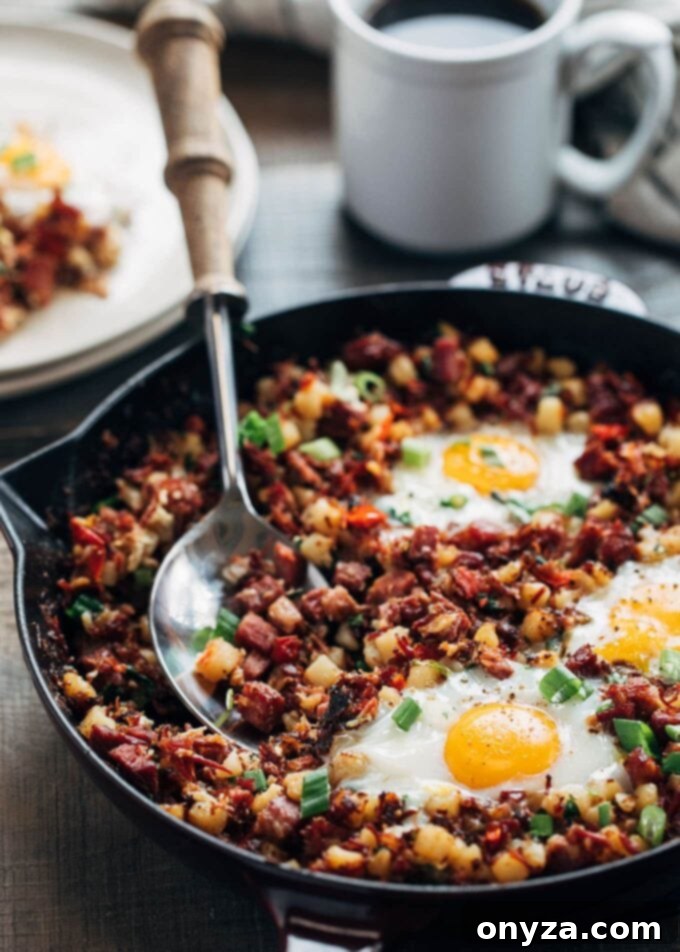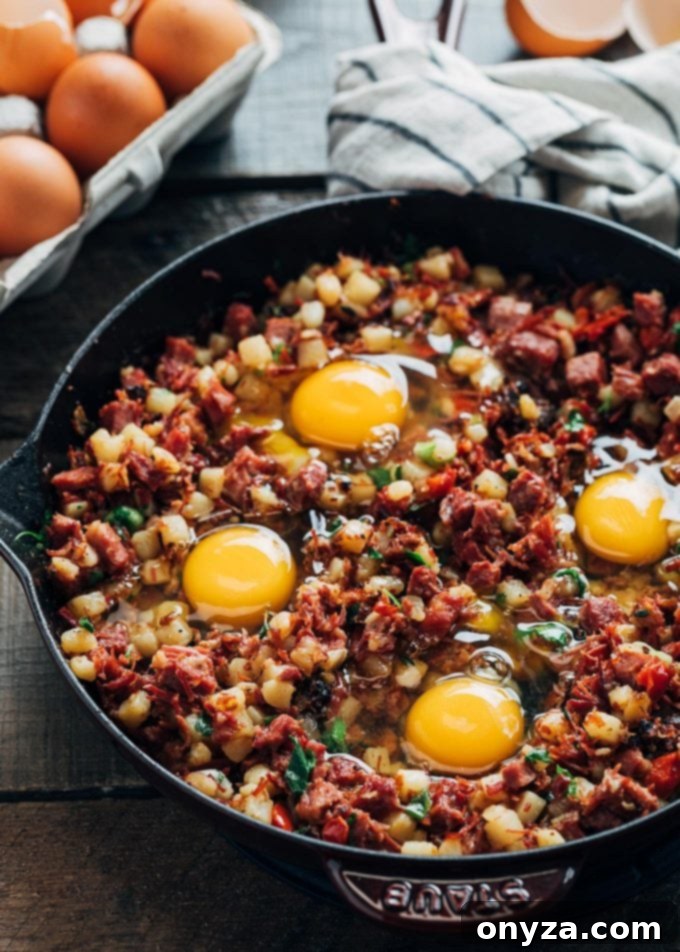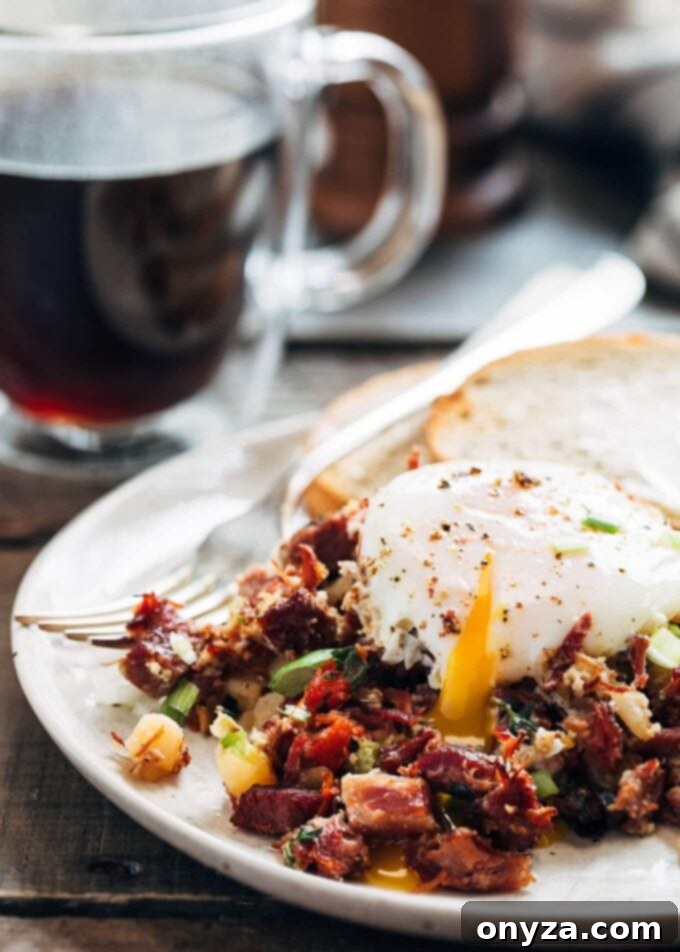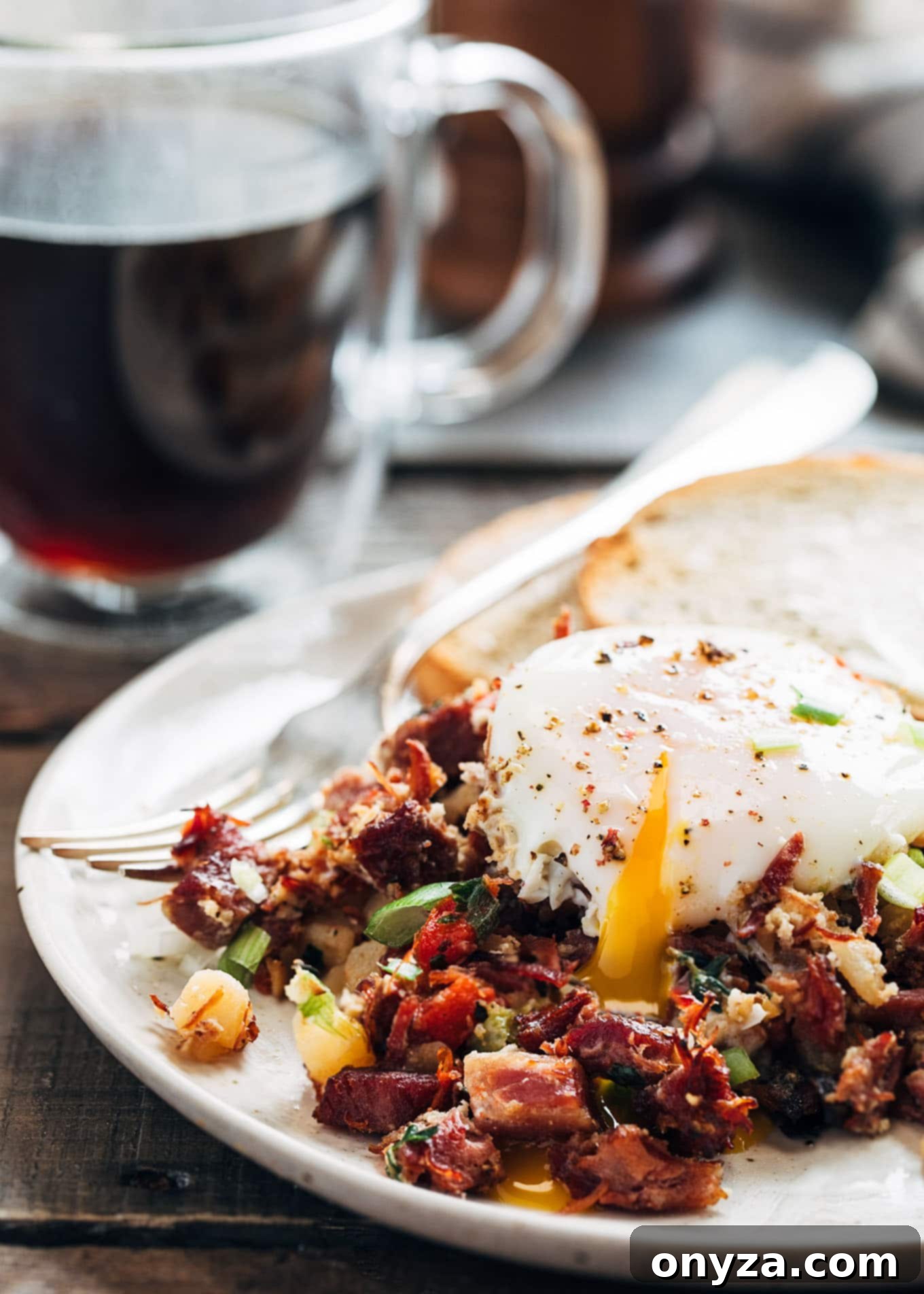Transform your St. Patrick’s Day leftovers into an unforgettable breakfast! This recipe for crispy, buttery Corned Beef Hash and Eggs offers a delicious and easy way to enjoy a hearty skillet meal any day of the week.

There’s a special kind of magic that comes with transforming the remnants of a grand feast into something equally, if not more, delightful than the original meal. For many, a big dinner means a new culinary adventure the following day. This sentiment rings especially true after celebratory occasions like St. Patrick’s Day. We intentionally prepare an abundance of corned beef, not just to savor the initial meal, but to look forward to the creative and comforting dishes that follow. It’s a cherished tradition that ensures the celebration extends beyond a single evening, filling our kitchen with enticing aromas and our plates with satisfying flavors. The joy of extending a holiday’s culinary delight into the days that follow is a simple pleasure that truly makes every bite count.
While a classic New Jersey deli-style corned beef sandwich remains a cherished lunchtime staple, the undisputed star of our post-holiday mornings is a sizzling pan of Corned Beef Hash and Eggs. This isn’t just any breakfast; it’s a cozy weekend ritual, a dish that embodies the very essence of comfort food and clever culinary reuse. It’s the perfect answer for anyone wondering, “What can I make with leftover corned beef?” – and the answer is always profoundly delicious, satisfying both hunger and the craving for a truly special morning meal.
Our signature buttery corned beef hash recipe creates an exquisite texture, where every bite offers a satisfying contrast: the deeply savory, crispy-edged hash beautifully complemented by the soft, gently baked eggs. There’s an unparalleled joy in breaking open a velvety yolk and watching its golden richness meld into the browned potatoes and tender corned beef. It’s a simple pleasure, yet profoundly satisfying, making it a truly essential breakfast experience that elevates humble leftovers into a gourmet delight. The combination of textures and flavors in this dish is truly what makes it one of those little things in life that’s simply everything.
Looking to prepare the perfect corned beef from scratch to ensure you have delicious leftovers? Explore my detailed recipes for: Instant Pot Corned Beef, Beer-Braised Corned Beef with Whiskey-Mustard Glaze, and Slow Cooker Corned Beef!

What is Corned Beef Hash? A Culinary Journey
At its heart, breakfast hash is a wonderfully versatile dish, typically crafted by frying a medley of leftover cooked meat with diced potatoes and often onions. The very name “hash” provides a clue to its origin, stemming from the French word hacher, meaning “to chop.” This historical connection highlights the dish’s fundamental nature: a humble yet ingenious way to transform chopped ingredients into a satisfying meal. It’s a testament to culinary resourcefulness, turning simple components into something greater than the sum of its parts.
The culinary roots of hash can be traced back through Britain and Europe, where resourceful cooks sought to make the most of every ingredient, particularly when meat was scarce or needed to be stretched. However, corned beef hash truly cemented its place in American cuisine during a pivotal time: World War II. During this era of rationing, fresh meat was a scarce commodity. Canned corned beef, readily available and economical, became a popular and practical substitute. This made corned beef hash an incredibly hearty, filling, and cost-effective meal that nourished families across the nation, becoming a symbol of resilience and comfort amidst hardship.
In the decades following the war, corned beef hash transcended its wartime necessity, evolving into a beloved breakfast tradition in many parts of America, particularly in the New England region. Its enduring popularity is a testament to its comforting flavors and easy preparation, establishing it as a staple on diner menus and breakfast tables alike. Today, you’ll find numerous creative variations, such as Red Flannel Hash, which incorporates diced beets to lend a distinctive earthy sweetness and a vibrant rosy hue to the dish. Beyond the classic, chefs and home cooks alike experiment with different meats, vegetables, and seasonings, proving that the simple concept of “hash” offers endless culinary possibilities and continues to delight palates with its savory charm.

Crafting the Perfect Corned Beef Hash and Eggs: Essential Techniques
While the core ingredients for corned beef hash remain consistent – meat and potatoes – thoughtful additions elevate a good hash to a truly great one. Onions are a foundational aromatic, providing a sweet and pungent base that deepens the overall flavor profile. To introduce a touch of color, freshness, and a subtle sweetness, I highly recommend including finely chopped bell pepper. Further brightening the profile are thinly sliced scallions and a medley of fresh herbs, such as Italian parsley and thyme. These fresh elements cut through the richness of the beef and potatoes, creating a more balanced and vibrant dish that feels both robust and lively.
Achieving that coveted crispy texture, the hallmark of an exceptional corned beef hash, relies on a few key techniques. Firstly, the choice of cookware is paramount: a heavy-duty cast iron skillet is your best friend here. Its superior heat retention and even heat distribution are crucial for developing those golden-brown, crispy edges on both the meat and potatoes. Unlike lighter pans, cast iron holds its temperature, allowing for consistent browning without hot spots. Secondly, the fat you cook with makes a significant difference. For unparalleled flavor and a rich, buttery crust, I always opt for unsalted butter. It infuses the hash with a depth that other oils simply can’t match, contributing to that irresistible aroma and taste.
For more insights into the magic of cast iron cooking, you might enjoy this article: Why the Cast Iron Skillet is the Key to Better One Pan Cooking from The Kitchn.
Now, for the secret to those glorious crispy bits: resist the urge to stir the hash constantly as it cooks. Frequent stirring prevents the ingredients from developing a beautiful crust. Instead, allow the hash to cook undisturbed for several minutes at a time, letting the heat work its magic. Use a sturdy spatula to gently press the mixture down, creating maximum contact with the hot pan, then flip in sections to ensure even browning. This method encourages the Maillard reaction, a complex chemical process that creates those irresistible savory flavors and crispy textures we all crave, especially on potatoes and meat. Listen for that satisfying sizzle – it’s not just noise; it’s the sound of delicious corned beef hash in the making, promising a delightful crunch with every forkful!

The Ultimate One-Pan Wonder: Baking Corned Beef Hash and Eggs
One of the most appealing aspects of corned beef hash is its remarkable adaptability, especially when transforming it into a convenient, one-pan breakfast skillet recipe. Once your hash has achieved that perfect crispy, savory balance on the stovetop, the next step is effortless. Simply use the back of a spoon to create shallow depressions or “wells” directly in the cooked hash. Carefully crack a fresh egg into each well, ensuring the yolk remains intact and nestled securely within the hash. Then, transfer the entire skillet to a preheated oven, allowing the eggs to gently bake to your desired level of doneness. This method simplifies cleanup significantly and beautifully integrates the eggs into the hash, making for an elegant presentation and a cohesive flavor experience that’s perfect for a leisurely weekend morning.
For those who cherish a runny, luscious yolk that enriches every bite, baking eggs in a breakfast skillet is incredibly efficient. In a 400°F (200°C) oven, eggs can reach this ideal state in as little as 8-14 minutes, depending on your preferred level of doneness. The magic truly happens when you pierce that delicate yolk on your plate, allowing its velvety goodness to cascade over the crispy-edged hash, creating a symphony of textures and flavors. It’s truly a moment of breakfast perfection, where the creamy yolk acts as a natural sauce, binding all the savory elements together.
If your preference leans towards a more soft-cooked, tender egg with a firmer yolk, simply extend the baking time by an additional 2-4 minutes. Keep in mind that precise cooking times can vary. Factors such as the size and initial temperature of your eggs, the specific heat retention properties of your skillet, and even the depth of the wells you create in the hash will all influence the final result. I always recommend beginning to check the eggs around the 8-minute mark and adjusting from there. A gentle wobble in the yolk usually indicates a perfectly runny center, while a firmer touch suggests a more set consistency. Trust your judgment and your oven!
While baked eggs offer incredible convenience and a wonderfully tender texture, it’s worth noting that they won’t develop the distinct thin, crispy edges that pan-fried eggs achieve. If those crispy edges are a non-negotiable for your breakfast experience (and we completely understand!), this corned beef hash recipe is equally delightful with eggs fried separately. Simply prepare your hash as directed, cooking it on the stovetop until perfectly crisp. Then, fry your eggs in a separate pan to your preferred doneness and serve them gloriously atop generous scoops of the savory, crispy hash. The choice is yours, ensuring a personalized and perfectly satisfying meal every time, tailored to your exact egg preference.
Tips and Variations for Your Best Corned Beef Hash
To elevate your corned beef hash, consider these expert tips and delightful variations:
- Potato Perfection: While russet potatoes are excellent for crisping, experiment with Yukon Gold for a creamier texture or sweet potatoes for a touch of sweetness and vibrant color. Ensure potatoes are diced evenly for consistent cooking – uniformity is key for even browning.
- Herb Power: Don’t limit yourself to parsley and thyme. Fresh rosemary or sage can add a deeper, earthier note that complements corned beef beautifully. Add them in the last few minutes of cooking to preserve their delicate flavors and aromas.
- Spice It Up: A pinch of smoked paprika, a dash of cayenne pepper, or a few shakes of your favorite hot sauce can add a wonderful kick to your hash, enhancing its savory depth. For a more global twist, try a touch of cumin or coriander.
- Cheese Please: For an extra layer of decadence, sprinkle some shredded sharp cheddar, Swiss, or Gruyère cheese over the hash before cracking the eggs, or right after they come out of the oven. The melting cheese will add a gooey, savory dimension that pairs beautifully with the corned beef.
- Serving Suggestions: Beyond the eggs, consider serving your corned beef hash with a side of toasted artisan bread or English muffins, a dollop of sour cream or crème fraîche, a sprinkle of fresh chives, or even a side of tangy pickled onions or a bright, simple salad to cut through the richness.
- Make Ahead: The hash mixture (without the chicken stock or eggs) can be prepared ahead of time and refrigerated in an airtight container for up to 2-3 days. When ready to serve, reheat it thoroughly in the cast iron skillet until hot and crispy, then proceed with adding the stock and eggs for baking.
Frequently Asked Questions About Corned Beef Hash and Eggs
- Can I use canned corned beef for this recipe?
- Absolutely! While this recipe is optimized for leftover cooked corned beef, canned corned beef can certainly be used. Drain it well, break it up with a fork, and add it to the skillet as you would the fresh cubed corned beef. The texture might be slightly different – often a bit softer – but the classic savory flavor will still be delicious and hearty.
- What’s the best way to get crispy potatoes?
- The key to ultra-crispy potatoes lies in two steps: first, pre-steam them until they are just tender (not mushy), then allow them to drain and dry thoroughly. Moisture is the enemy of crispiness! Second, avoid overcrowding the pan, and resist the urge to stir frequently. Let them sit undisturbed in the hot, buttered skillet for several minutes at a time to develop that beautiful golden-brown crust before flipping.
- Can I make this recipe without a cast iron skillet?
- Yes, you can use any heavy-bottomed, oven-safe skillet or Dutch oven. However, a cast iron skillet provides superior heat retention and distribution, which is ideal for achieving the crispiest hash and ensuring the eggs bake evenly. If using another type of pan, ensure it can safely withstand oven temperatures of 400°F (200°C) and cooks as evenly as possible.
- How do I store and reheat leftover corned beef hash?
- Store any leftover hash (ideally without the baked eggs, as they tend to become rubbery when reheated) in an airtight container in the refrigerator for up to 3-4 days. To reheat, spread it in a hot skillet with a little butter or oil over medium-high heat until crispy and heated through. You can then fry fresh eggs to serve alongside for the best results.
- Is corned beef hash only for breakfast?
- Not at all! While it’s a quintessential breakfast or brunch dish, its hearty and satisfying nature makes it excellent for a casual lunch or even a simple, comforting dinner. Pair it with a fresh green salad or some crusty bread to balance the richness, and enjoy it any time of day you crave a substantial, flavorful meal.

★
★
★
★
Corned Beef Hash and Eggs
Amanda Biddle
10 minutes
45 minutes
55 minutes
4 to 6 servings
Ingredients
- ¾ pound cooked corned beef , cut into ½-inch cubes (about 2½ cups)
- 1 pound russet potatoes , cut into ¼-inch dice (about 2¾ cups)
- ½ cup diced red bell pepper
- ¾ cup diced yellow onion
- 4 tablespoons unsalted butter
- ¼ cup thinly-sliced scallions
- ¼ cup Italian parsley , chopped
- 1 teaspoon fresh thyme leaves , chopped
- ¼ cup chicken stock
- 4-6 large eggs
- kosher salt and freshly ground black pepper
Instructions
- Preheat oven to 400°F (200°C).
- Prepare the potatoes: Fill a pot large enough to hold a steamer basket with a couple of inches of water. Bring to a boil. Add diced potatoes to the steamer basket, cover the pot, lower the heat, and steam for 5-7 minutes, until the potatoes are just tender when pierced with a fork but not mushy. Set aside and allow to drain and dry slightly.
- Sauté vegetables: Melt butter over medium-high heat in a 10-inch, nonstick, oven-safe skillet (preferably cast iron). Add the diced onion, bell pepper, and ½ teaspoon each of kosher salt and freshly ground black pepper. Sauté, stirring occasionally, until the vegetables are softened and translucent, about 5 minutes.
- Brown the hash: Stir in the cubed corned beef and cook for about 3 minutes, until some of its fat is rendered and the beef just begins to brown. Add the steamed potatoes to the skillet. Cook the hash, occasionally (and gently) pressing it down with a spatula and flipping in sections, until the potatoes are nicely browned and crispy, and the corned beef is golden and crisp in areas. This typically takes about 6-10 minutes.
- Finish the hash: Stir in the thinly sliced scallions, chopped fresh thyme, and Italian parsley. Taste and season further with salt and pepper as needed, ensuring the flavors are perfectly balanced.
- Add eggs and bake: Drizzle the chicken stock evenly over the hash. Use the back of a spoon or ladle to create 4-6 shallow wells in the hot hash (depending on the number of servings and eggs desired). Carefully crack one large egg into each well. Transfer the skillet to the preheated oven and bake until the egg whites are set and the yolks are still wonderfully runny (this typically takes 8-14 minutes, but can vary based on your skillet, the depth of the wells, and the initial temperature of your eggs), or bake to your preferred doneness.
- Serve: Immediately sprinkle the baked eggs with a pinch of salt and cracked black pepper. Serve the Corned Beef Hash and Eggs hot, directly from the skillet, and enjoy!
Notes
Using Leftover Cooked Potatoes: If you happen to have leftover cooked potatoes (perhaps from your corned beef dinner), you can easily incorporate them into this breakfast hash! Skip the initial steaming step (Instruction 2), dice the cooked potatoes, and proceed with the recipe as written from Instruction 3 onwards. This is a fantastic way to minimize waste and speed up prep time.
Nutrition Estimate (per serving)
Carbohydrates: 26g |
Protein: 24g |
Fat: 30g |
Saturated Fat: 13g |
Cholesterol: 310mg |
Sodium: 1158mg |
Potassium: 949mg |
Fiber: 2g |
Sugar: 3g |
Vitamin A: 1675IU |
Vitamin C: 62.4mg |
Calcium: 76mg |
Iron: 4.1mg
Nutrition information is automatically calculated, so should only be used as an approximation.
Please note that our recipes have been developed using the US Customary measurement system and have not been tested for high altitude/elevation cooking and baking.
Enjoyed this recipe? Please rate and share your comments below!
